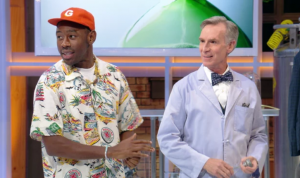Bill Nye the Science Guy Explores Addiction
By Helaina Hovitz

Within the first minute of Bill Nye’s episode on addiction you realize you’re not five years old anymore, and this is definitely not the same Science Guy you used to watch back then.
Bill Nye with Tyler, the Creator on the set of “Bill Nye Saves the World”
Bill Nye brings celebrities on his show to take part in science demonstrations.
There’s nothing like watching Bill Nye spiral through too much coffee, scratch-off lottery tickets, social media, pills, gambling, and booze—all within the first minute of his episode on addiction—to make you realize you’re not five years old anymore, and this is definitely not the same show you used to watch back then.
Although, it does push enough similarity buttons to hit that nostalgia chord pretty hard.
So why now, after his first run of Bill Nye the Science Guy, and two seasons of his Netflix show Bill Nye Saves the World under his belt, is it time for “The Addiction Episode,” with a logline that echoes the refrain of many a Fix article: “Is addiction a moral failing, a genetic predilection, or a product of your environment? Addiction ruins lives; can science help us stop?”
We decided to ask him ourselves.
“It’s a show about your brain, and everyone’s fascinated with brains. This is where chemistry crosses into consciousness like your perception, similar to chicken and egg. Which came first? Your predisposition to addiction, or the drugs that induce addiction, or the behavior that caused you to become an addict?” Nye said.
“And, addiction has affected everyone you’ll meet.”
True story, at least as far as his studio audience is concerned, nearly all of whom raise their hands when asked if they know someone living with addiction, whether in recovery or not.
He continues to tell his viewers, “Society, being what it is, thinks a person becomes a drug addict or an alcoholic because of an obvious choice, a moral failing or weakness…we assume if they’d just ‘fly right’ the addiction would go away.”
“Addiction is a huge problem for our society. It’s very expensive. You have addicts getting addicted to all sorts of things and they become unproductive, they destroy their families, and they, for better or for worse, have very low qualities of life,” he told The Fix.
“Of course, they become a burden for everybody so it’s lose-lose, and we want to understand it. How do people get addicted to gambling, which has no chemical involved at all, in the same way you get addicted to alcohol? It affects the same part of the brain. It’s amazing.”
To illustrate how indiscriminately powerful addiction can be, affecting people from all walks of life, Nye shared with The Fix a story about a very close friend whose wife broke her ankle and got addicted to Oxycontin. It ruined their family, he said. “It was horrible. It went on for years and years…she got into harder and harder drugs. She was an accessory to murder with a drug dealer, and this was a family that was very well off because of their success and careers. It was really heartbreaking.”
The biggest myth he’s out to debunk, though, is that addiction is a choice.
“It’s much deeper than that,” he told us. “By that, I mean it’s biochemical, it’s deep in your brain, it’s the chemistry of your brain. Now, the environment plays a pretty big role in whether someone becomes an addict, but the problem at some level is your brain. The genes of your brain that you’re dealt.”
The show features an interview with comedian and actress Maria Bamford, who describes her first “addictive process”: an eating disorder which started at 10 years old and which eventually led her to consider suicide. At 21 she found relief in a 12-step program, and over time ended up going to “a number of those different programs.” When asked if she now compulsively goes to meetings, she replied “if humanity, and the love of humankind, is addictive, then, yes, I am definitely addicted.” As an atheist, she explained, she deals with the heavy spiritual component in 12-step meetings by substituting Neil deGrasse Tyson for every mention of “higher power” or “god.”
Nye says he brought Bamford on because “She’s funny, she has a respect for her condition that I think people can appreciate and relate to.”
The episode goes on to differentiate between addiction to substances and behavioral addictions such as shopping and gambling. A cutaway segment features an in-person visit to a lab in St. Louis set up to look like a casino, complete with clock-less walls and a cold temperature. In this lab, researchers conduct MRI’s in order to study the brain’s response to certain stimuli and activities related to the act of gambling.
The big takeaway: Change is possible. The same way the brain changed when it became addicted, it can change back.
Nye also hosts a panel discussion about addiction treatment featuring Cara Santa Maria, neuroscientist Dr. Carl Hart, and an officer of the law in Ohio who says that in his precinct, they help people get sober rather than just locking them up, and out of 2,400 “clients” who are part of that program, there is an 81% success rate of people now living clean. Among many other salient points, Cara Santa Maria emphasized the necessity for individualized treatment options above and beyond 12-step, which doesn’t have a great success rate; and Dr. Carl Hart advocated for less hysteria and moralizing and more comprehensive assessments, pointing out that the majority of people who use drugs—including so-called “hard drugs” like heroin and methamphetamine—do not become addicted.
In his characteristic super simple way, Nye explains, it’s both nature and nurture that causes us to start using whatever thing it is we were using not only to feel good, but also to keep from feeling bad, and then as our brains become accustomed to the substance or behavior we need to increase it to achieve the same effect. “Then,” he observes, “when you stop, you don’t enjoy anything else. Right?”
Nye packs a lot more into the half hour episode, including a rant by the long-dead inventor of cocaine (and mustard gas), an interview with Addiction, played by a laid back and slightly sinister Judah Friedlander, and an unrelated but interesting segment on aquaculture and why we should all be eating more fish.
When asked whether he feels that he’s approached it successfully in his signature Bill Nye way that other outlets can’t quite master, he turned the question back on us:
“I understand it and I love leading questions. Did I do it better than anybody else? I don’t know, but certainly that’s the goal,” he said. “You want to come at it from a scientific standpoint, not from a judging as bad standpoint. You don’t want to go into it with your mind already made up. It’s science!”
Check out the new season of Bill Nye Saves the World on Netflix.

